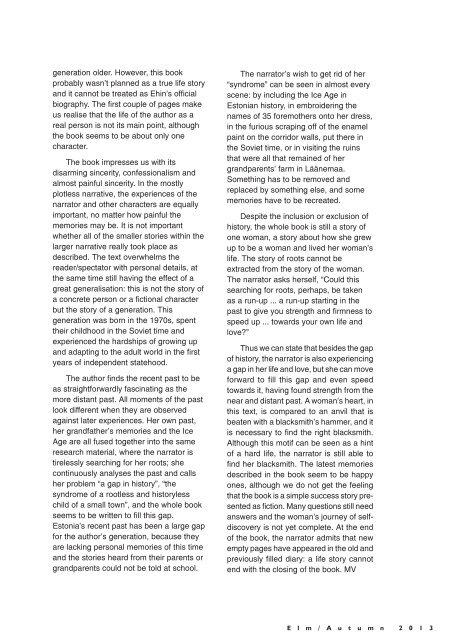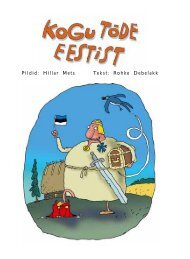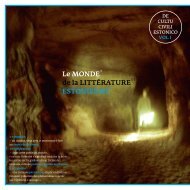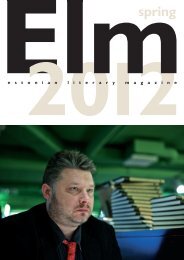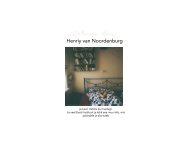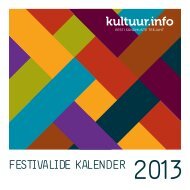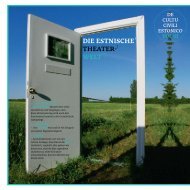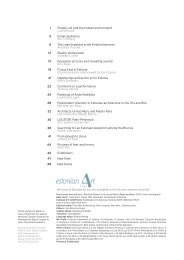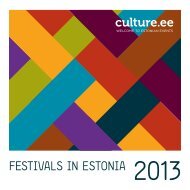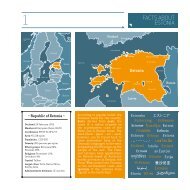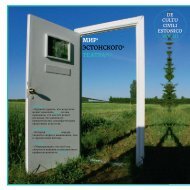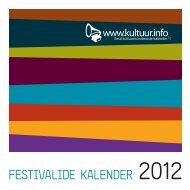Autumn 2013
Autumn 2013
Autumn 2013
You also want an ePaper? Increase the reach of your titles
YUMPU automatically turns print PDFs into web optimized ePapers that Google loves.
generation older. However, this book<br />
probably wasn’t planned as a true life story<br />
and it cannot be treated as Ehin’s official<br />
biography. The first couple of pages make<br />
us realise that the life of the author as a<br />
real person is not its main point, although<br />
the book seems to be about only one<br />
character.<br />
The book impresses us with its<br />
disarming sincerity, confessionalism and<br />
almost painful sincerity. In the mostly<br />
plotless narrative, the experiences of the<br />
narrator and other characters are equally<br />
important, no matter how painful the<br />
memories may be. It is not important<br />
whether all of the smaller stories within the<br />
larger narrative really took place as<br />
described. The text overwhelms the<br />
reader/spectator with personal details, at<br />
the same time still having the effect of a<br />
great generalisation: this is not the story of<br />
a concrete person or a fictional character<br />
but the story of a generation. This<br />
generation was born in the 1970s, spent<br />
their childhood in the Soviet time and<br />
experienced the hardships of growing up<br />
and adapting to the adult world in the first<br />
years of independent statehood.<br />
The author finds the recent past to be<br />
as straightforwardly fascinating as the<br />
more distant past. All moments of the past<br />
look different when they are observed<br />
against later experiences. Her own past,<br />
her grandfather’s memories and the Ice<br />
Age are all fused together into the same<br />
research material, where the narrator is<br />
tirelessly searching for her roots; she<br />
continuously analyses the past and calls<br />
her problem “a gap in history”, “the<br />
syndrome of a rootless and historyless<br />
child of a small town”, and the whole book<br />
seems to be written to fill this gap.<br />
Estonia’s recent past has been a large gap<br />
for the author’s generation, because they<br />
are lacking personal memories of this time<br />
and the stories heard from their parents or<br />
grandparents could not be told at school.<br />
The narrator’s wish to get rid of her<br />
“syndrome” can be seen in almost every<br />
scene: by including the Ice Age in<br />
Estonian history, in embroidering the<br />
names of 35 foremothers onto her dress,<br />
in the furious scraping off of the enamel<br />
paint on the corridor walls, put there in<br />
the Soviet time, or in visiting the ruins<br />
that were all that remained of her<br />
grandparents’ farm in Läänemaa.<br />
Something has to be removed and<br />
replaced by something else, and some<br />
memories have to be recreated.<br />
Despite the inclusion or exclusion of<br />
history, the whole book is still a story of<br />
one woman, a story about how she grew<br />
up to be a woman and lived her woman’s<br />
life. The story of roots cannot be<br />
extracted from the story of the woman.<br />
The narrator asks herself, “Could this<br />
searching for roots, perhaps, be taken<br />
as a run-up ... a run-up starting in the<br />
past to give you strength and firmness to<br />
speed up ... towards your own life and<br />
love?”<br />
Thus we can state that besides the gap<br />
of history, the narrator is also experiencing<br />
a gap in her life and love, but she can move<br />
forward to fill this gap and even speed<br />
towards it, having found strength from the<br />
near and distant past. A woman’s heart, in<br />
this text, is compared to an anvil that is<br />
beaten with a blacksmith’s hammer, and it<br />
is necessary to find the right blacksmith.<br />
Although this motif can be seen as a hint<br />
of a hard life, the narrator is still able to<br />
find her blacksmith. The latest memories<br />
described in the book seem to be happy<br />
ones, although we do not get the feeling<br />
that the book is a simple success story presented<br />
as fiction. Many questions still need<br />
answers and the woman’s journey of selfdiscovery<br />
is not yet complete. At the end<br />
of the book, the narrator admits that new<br />
empty pages have appeared in the old and<br />
previously filled diary: a life story cannot<br />
end with the closing of the book. MV<br />
E l m / A u t u m n 2 0 1 3


